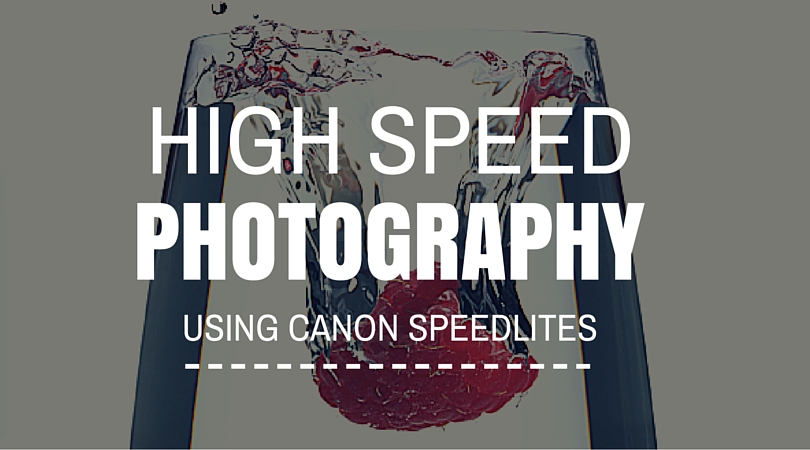
This article is an excerpt from Mastering Canon EOS Flash Photography, 2nd Edition.
All images and content are by NK Guy
While flash units are used today mainly as a photographic light sources, the flash tube was originally used as a device for stopping time—at least, photographically speaking. In the mid-1920s, MIT’s Harold Edgerton was studying the behavior of synchronous electric motors. He had made some calculations predicting their performance and built a mercury arc lamp that could photograph the spinning motors as they were put under load, thereby testing his theories. Over the next few years, he generalized the concept for photographic applications, eventually switching to xenon gas in the tubes. Edgerton was following in the footsteps of photographic pioneer William Henry Fox Talbot, who in June 1851 used an electric spark to freeze the motion of a sheet of paper fastened to a rotating disc.
Today, the same photographic flash units that are used for snapping photos can be used for freezing motion. The duration of a flash pulse can be set in milliseconds, making it much faster than a mechanical shutter. Since the light pulses are so brief, exceeding the highest shutter speeds of most cameras, the field is often called high-speed photography. There are a few basic points to keep in mind.
First, the faster the object motion that needs to be stopped, the briefer the flash of light needed to freeze it. Ordinary subjects, such as people and slow-moving cars, can easily be frozen by the pulse of light from a regular flash unit. For this reason, portraits and similar shots always look sharper when taken with flash. However, really fast-moving objects such as water drops, hummingbirds, and bullets need extremely brief light pulses.
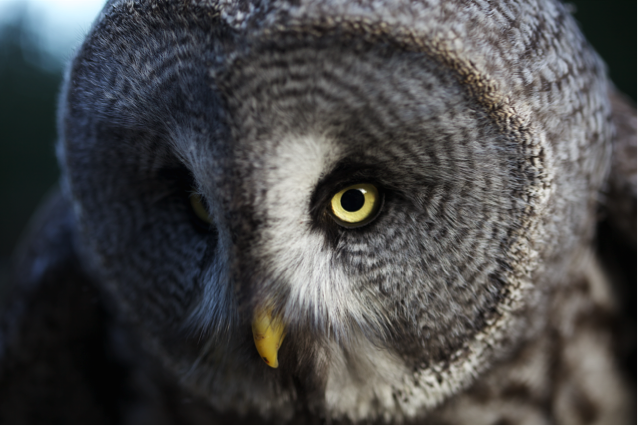
Even captive and trained animals move around unpredictably, such as this great grey owl (Strix nebulosa) at the Birds of Prey Centre, Old Warden Park, England. A wireless 580EX and reflector held camera right was perfect for freezing the motion of the owl as it looked around.
Second, AC powered studio gear is usually not the best option for freezing motion. Most studio units control the brightness of light output by changing the amount of power discharged through the tube. They often have long
“tails” as light output drops off. In contrast, battery-powered flash units control overall light output by altering the duration of the flash pulse. A full power pulse from a Speedlite-type unit is actually not all that brief—values of 1/700 sec to 1/1000 sec are typical. But at low power settings, the light produced by battery units is extremely brief, since power to the tube is cut off very rapidly. Therefore, high-speed photography is best performed with ordinary battery flash units at low power settings, or studio units designed specifically for motion-freezing purposes. If the light from one unit is insufficient, then multiple units can be set up to fire simultaneously. Note also that many flash units will extend the duration if power is low, and the fastest flash bursts will be from fully charged units.
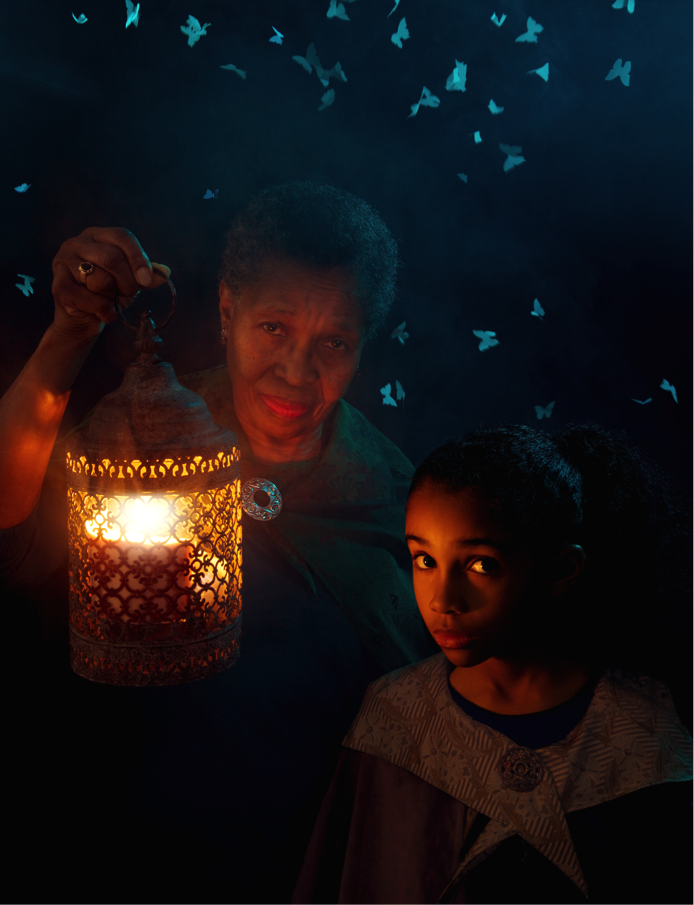
A studio flash unit was used to backlight the falling paper moths, but the pulse of light wasn’t brief enough to freeze them completely. This was actually intentional, since the blurred edges of the ethereal moths help convey a timeless fairy tale feeling. A story of a woman and her granddaughter lost in some mysterious place, their way guided by some magical moths. Or something. The interior of the lantern was lit by a 430EX III RT in radio slave mode. An orange gel, a cylinder of paper, and some bubble wrap plastic simulated a candle. At camera left, a studio flash unit, with a blue-gelled gridded dish was used for foreground fill. A blue-gelled studio flash unit on a tall light stand was used to simulate moonlight and outline the models’ hair and shoulders. Barn doors were used to pre-vent spill onto the black backdrop paper. Finally, moths cut from vellum paper were shaken down from a tray above and behind the models.
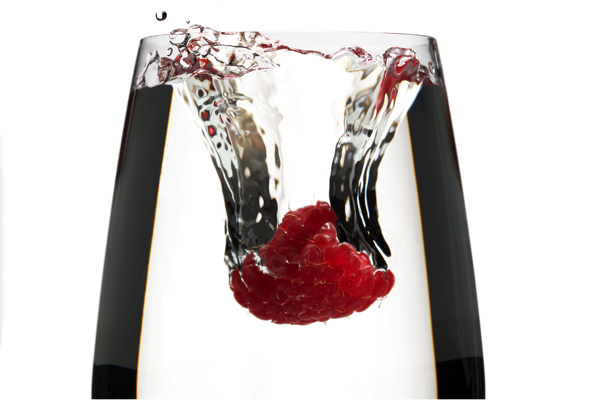
This shot from the cover of the first edition of this book was taken without any specialized equipment. I set up a 580EX II behind a translucent screen and a 420EX to camera right. I then dropped raspberries into a water-filled wine glass, firing a manual shutter release over and over. It took quite a few attempts to get the timing right, since the flash has to sync to an event (the splash in this case) and not to the shutter opening.
Manual timing is pretty tedious work, so a flash trigger timer is highly recommended for high-speed photography. These electronic devices can fire a flash after a beam of light is broken (a falling water drop, say) or after a microphone hears a sound (perhaps a balloon popping). Variable time delays can then be set so that the flash fires at the perfect moment to capture the action.
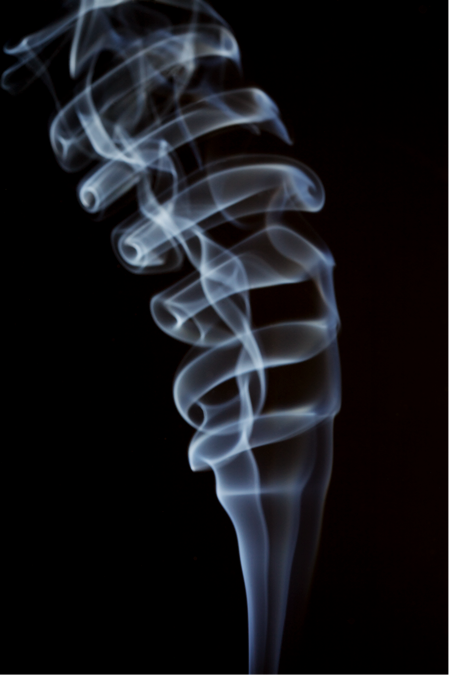
The complex curl of smoke from a stick of incense, frozen by a burst of flash from a 580EX II.
Many people build their own high-speed triggers, so this has become a popular photographic hobby. However, people low on electronic skills or time can also purchase advanced computerized flash triggers.
Some of these, like the Universal Photo Timer from UniversalTimer.com, can perform time lapse photography and other timed work as an infrared remote; it can trigger cameras and flash units in response to external events such as water drops and the like; it can work as an optical slave for a flash unit; it can perform stroboscopic flash; and it can operate as a remote shutter release. It has two sockets for controlling two separate flash units.
The right-hand device, the StopShot timer from Cognisys, has an advanced LCD screen with control over three separate output devices plus timing and intervalometer options. It supports conditional triggers for crossed beams (e.g., a flying insect will only trigger a shot if two beams are broken, not just one) and can memorize preset configurations. The maker also sells a variety of input devices, such as laser sensors.
This excerpt was taken from Mastering Canon EOS Flash Photography, 2nd Edition, which is available now in paperback, ebook, and bundle versions! Click to get your copy today!
